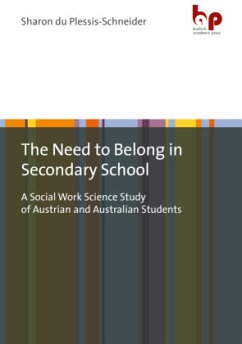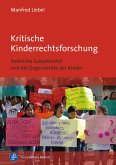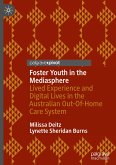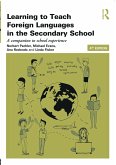Sharon du Plessis-Schneider
The Need to Belong in Secondary School
A Social Work Science Study of Austrian and Australian Students
Sharon du Plessis-Schneider
The Need to Belong in Secondary School
A Social Work Science Study of Austrian and Australian Students
- Broschiertes Buch
- Merkliste
- Auf die Merkliste
- Bewerten Bewerten
- Teilen
- Produkt teilen
- Produkterinnerung
- Produkterinnerung
Unsere sozialen Interaktionen werden von komplexen biopsychischen Prozessen angetrieben, die dadurch verkompliziert werden, dass der Mensch ein Individuum ist und gleichzeitig Mitglied eines oder mehrerer sozialer Systeme, wie bspw. der Schule. Dieses Buch trägt dazu bei, die sozialen Mechanismen des "Bedürfnisses nach Zugehörigkeit" bei Schüler_innen in Schulkontexten zu erklären. Der theoretische Rahmen basiert auf einem Verständnis von Bedürfnissen als kognitive Mechanismen neuronaler Prozesse, die menschliches Verhalten und Körperwerte regulieren. Die Feldforschung wurde in zwei…mehr
Andere Kunden interessierten sich auch für
![Demokratiebildung in Verfahren der Qualitätsentwicklung in Kitas: Eine Dokumentenanalyse Demokratiebildung in Verfahren der Qualitätsentwicklung in Kitas: Eine Dokumentenanalyse]() Hoa Mai Tr_nDemokratiebildung in Verfahren der Qualitätsentwicklung in Kitas: Eine Dokumentenanalyse52,00 €
Hoa Mai Tr_nDemokratiebildung in Verfahren der Qualitätsentwicklung in Kitas: Eine Dokumentenanalyse52,00 €![Kinder als Akteure nachhaltiger Entwicklung Kinder als Akteure nachhaltiger Entwicklung]() Barbara BenoistKinder als Akteure nachhaltiger Entwicklung36,90 €
Barbara BenoistKinder als Akteure nachhaltiger Entwicklung36,90 €![Schulische Inklusion Schulische Inklusion]() Katharina ReschSchulische Inklusion19,90 €
Katharina ReschSchulische Inklusion19,90 €![Kritische Kinderrechtsforschung Kritische Kinderrechtsforschung]() Manfred LiebelKritische Kinderrechtsforschung34,90 €
Manfred LiebelKritische Kinderrechtsforschung34,90 €![Foster Youth in the Mediasphere Foster Youth in the Mediasphere]() Milissa DeitzFoster Youth in the Mediasphere34,99 €
Milissa DeitzFoster Youth in the Mediasphere34,99 €![Learning to Teach Foreign Languages in the Secondary School Learning to Teach Foreign Languages in the Secondary School]() Norbert PachlerLearning to Teach Foreign Languages in the Secondary School35,99 €
Norbert PachlerLearning to Teach Foreign Languages in the Secondary School35,99 €![Pedagogical Innovation for Children's Agency in the Classroom Pedagogical Innovation for Children's Agency in the Classroom]() Federico FariniPedagogical Innovation for Children's Agency in the Classroom112,99 €
Federico FariniPedagogical Innovation for Children's Agency in the Classroom112,99 €-
-
-
Unsere sozialen Interaktionen werden von komplexen biopsychischen Prozessen angetrieben, die dadurch verkompliziert werden, dass der Mensch ein Individuum ist und gleichzeitig Mitglied eines oder mehrerer sozialer Systeme, wie bspw. der Schule. Dieses Buch trägt dazu bei, die sozialen Mechanismen des "Bedürfnisses nach Zugehörigkeit" bei Schüler_innen in Schulkontexten zu erklären. Der theoretische Rahmen basiert auf einem Verständnis von Bedürfnissen als kognitive Mechanismen neuronaler Prozesse, die menschliches Verhalten und Körperwerte regulieren. Die Feldforschung wurde in zwei Sekundarschulen in Österreich und Australien durchgeführt. Handlungsleitlinien, die Schüler_innen dabei helfen sollen, sich zugehörig zu fühlen, werden von den Ergebnissen abgeleitet.
Hinweis: Dieser Artikel kann nur an eine deutsche Lieferadresse ausgeliefert werden.
Hinweis: Dieser Artikel kann nur an eine deutsche Lieferadresse ausgeliefert werden.
Produktdetails
- Produktdetails
- Verlag: Budrich Academic Press / Verlag Barbara Budrich
- Artikelnr. des Verlages: 12087
- Seitenzahl: 290
- Erscheinungstermin: 12. Juli 2022
- Englisch
- Abmessung: 17mm x 148mm x 210mm
- Gewicht: 375g
- ISBN-13: 9783966650458
- Artikelnr.: 63752291
- Herstellerkennzeichnung Die Herstellerinformationen sind derzeit nicht verfügbar.
- Verlag: Budrich Academic Press / Verlag Barbara Budrich
- Artikelnr. des Verlages: 12087
- Seitenzahl: 290
- Erscheinungstermin: 12. Juli 2022
- Englisch
- Abmessung: 17mm x 148mm x 210mm
- Gewicht: 375g
- ISBN-13: 9783966650458
- Artikelnr.: 63752291
- Herstellerkennzeichnung Die Herstellerinformationen sind derzeit nicht verfügbar.
Sharon du Plessis-Schneider, MSW, is a lecturer at the University of Applied Sciences Vorarlberg in Dornbirn, Austria.
PART I: Research focus and theoretical framework
1 Introduction
1.1 Defining "belonging" and "need to belong"
1.2 Research problem
1.3 Aim and research questions
1.4 The conceptual framework
1.5 Summary and consequences for the research design
2 Needs, human rights, school social work
2.1 Austria: school social work
2.2 Australia: school social work
2.3 School social workers and human rights
2.4 Education, Bildung and didactics
2.5 Human rights framework for school Bildung and education
2.6 Austrian school education
2.7 Australian school education
2.8 Summary
3 Literature review on needs and student belonging
3.1 Children's needs, rights and wellbeing
3.2 Belonging as a psychological need
3.3 Interactions and social relationships
3.4 Membership as a determinant of belonging
3.5 Teachers fostering student belonging
3.6 Academic engagement
3.7 School environment
3.8 Heterogeneity and difference
3.9 Non-belonging and social exclusion
3.10 Summary
4 A conceptual framework based on theories of human need
4.1 Key concepts: theory, system and mechanism
4.2 Research on the historical perspectives of human need
4.3 Human needs and welfare science - Arlt, 1876 - 1960
4.4 Humanistic psychology and needs - Maslow, 1908-1970
4.5 Human needs in pedagogy - Mägdefrau, 1960
4.6 Biopsychic-social & cultural need theory - Obrecht, 1942
4.7 Synopses of human need across four need theories
4.8 Conceptualising the "need to belong"
4.9 Objections to human needs theories
4.10 Summary
PART II: Research design, data collection, analysis and findings
5 Research design
5.1 Ontology
5.2 Epistemology
5.3 Methodology
5.4 Case study
5.5 Observation
5.6 Focus groups
5.7 Ethical guidelines
5.8 Student voice
5.9 Characteristics of the research schools
5.10 Fieldwork at the school in Austria
5.11 Fieldwork at the school in Australia
5.12 Summary
6 The "need to belong" - the search for empirical evidence
6.1 Summarising the analyses as a methodological procedure
6.2 Individual student-based data analysis 6.3 Categories within four dimensions of belonging
6.4 Whole group analysis
6.5 Whole group analysis coding framework
6.6 Summary
7 Theoretical model and principles of general action
7.1 Theory model of the "need to belong"
7.2 Transdisciplinary knowledge in response to social problems
7.3 Principles of action: three-step transformative approach
7.4 Formulation of theoretical hypotheses
7.5 Formulation of action-theory working hypotheses
7.6 Formulation of general guidelines for action
7.7 Aligning the empirical findings with previous research
7.8 Summary
8 Findings and recommendations for the "need to belong"
8.1 Conceptual, theoretical, methodological contributions
8.2 Discussion of the individual student-based analysis
8.3 Discussion of the findings from the whole group analysis
8.4 Discussion of the transformative three-step approach
8.5 Reflections on the triple mandate of school social work
8.6 Heterogeneity facilitates student belonging
8.7 Suggestions for future research
1 Introduction
1.1 Defining "belonging" and "need to belong"
1.2 Research problem
1.3 Aim and research questions
1.4 The conceptual framework
1.5 Summary and consequences for the research design
2 Needs, human rights, school social work
2.1 Austria: school social work
2.2 Australia: school social work
2.3 School social workers and human rights
2.4 Education, Bildung and didactics
2.5 Human rights framework for school Bildung and education
2.6 Austrian school education
2.7 Australian school education
2.8 Summary
3 Literature review on needs and student belonging
3.1 Children's needs, rights and wellbeing
3.2 Belonging as a psychological need
3.3 Interactions and social relationships
3.4 Membership as a determinant of belonging
3.5 Teachers fostering student belonging
3.6 Academic engagement
3.7 School environment
3.8 Heterogeneity and difference
3.9 Non-belonging and social exclusion
3.10 Summary
4 A conceptual framework based on theories of human need
4.1 Key concepts: theory, system and mechanism
4.2 Research on the historical perspectives of human need
4.3 Human needs and welfare science - Arlt, 1876 - 1960
4.4 Humanistic psychology and needs - Maslow, 1908-1970
4.5 Human needs in pedagogy - Mägdefrau, 1960
4.6 Biopsychic-social & cultural need theory - Obrecht, 1942
4.7 Synopses of human need across four need theories
4.8 Conceptualising the "need to belong"
4.9 Objections to human needs theories
4.10 Summary
PART II: Research design, data collection, analysis and findings
5 Research design
5.1 Ontology
5.2 Epistemology
5.3 Methodology
5.4 Case study
5.5 Observation
5.6 Focus groups
5.7 Ethical guidelines
5.8 Student voice
5.9 Characteristics of the research schools
5.10 Fieldwork at the school in Austria
5.11 Fieldwork at the school in Australia
5.12 Summary
6 The "need to belong" - the search for empirical evidence
6.1 Summarising the analyses as a methodological procedure
6.2 Individual student-based data analysis 6.3 Categories within four dimensions of belonging
6.4 Whole group analysis
6.5 Whole group analysis coding framework
6.6 Summary
7 Theoretical model and principles of general action
7.1 Theory model of the "need to belong"
7.2 Transdisciplinary knowledge in response to social problems
7.3 Principles of action: three-step transformative approach
7.4 Formulation of theoretical hypotheses
7.5 Formulation of action-theory working hypotheses
7.6 Formulation of general guidelines for action
7.7 Aligning the empirical findings with previous research
7.8 Summary
8 Findings and recommendations for the "need to belong"
8.1 Conceptual, theoretical, methodological contributions
8.2 Discussion of the individual student-based analysis
8.3 Discussion of the findings from the whole group analysis
8.4 Discussion of the transformative three-step approach
8.5 Reflections on the triple mandate of school social work
8.6 Heterogeneity facilitates student belonging
8.7 Suggestions for future research
PART I: Research focus and theoretical framework
1 Introduction
1.1 Defining "belonging" and "need to belong"
1.2 Research problem
1.3 Aim and research questions
1.4 The conceptual framework
1.5 Summary and consequences for the research design
2 Needs, human rights, school social work
2.1 Austria: school social work
2.2 Australia: school social work
2.3 School social workers and human rights
2.4 Education, Bildung and didactics
2.5 Human rights framework for school Bildung and education
2.6 Austrian school education
2.7 Australian school education
2.8 Summary
3 Literature review on needs and student belonging
3.1 Children's needs, rights and wellbeing
3.2 Belonging as a psychological need
3.3 Interactions and social relationships
3.4 Membership as a determinant of belonging
3.5 Teachers fostering student belonging
3.6 Academic engagement
3.7 School environment
3.8 Heterogeneity and difference
3.9 Non-belonging and social exclusion
3.10 Summary
4 A conceptual framework based on theories of human need
4.1 Key concepts: theory, system and mechanism
4.2 Research on the historical perspectives of human need
4.3 Human needs and welfare science - Arlt, 1876 - 1960
4.4 Humanistic psychology and needs - Maslow, 1908-1970
4.5 Human needs in pedagogy - Mägdefrau, 1960
4.6 Biopsychic-social & cultural need theory - Obrecht, 1942
4.7 Synopses of human need across four need theories
4.8 Conceptualising the "need to belong"
4.9 Objections to human needs theories
4.10 Summary
PART II: Research design, data collection, analysis and findings
5 Research design
5.1 Ontology
5.2 Epistemology
5.3 Methodology
5.4 Case study
5.5 Observation
5.6 Focus groups
5.7 Ethical guidelines
5.8 Student voice
5.9 Characteristics of the research schools
5.10 Fieldwork at the school in Austria
5.11 Fieldwork at the school in Australia
5.12 Summary
6 The "need to belong" - the search for empirical evidence
6.1 Summarising the analyses as a methodological procedure
6.2 Individual student-based data analysis 6.3 Categories within four dimensions of belonging
6.4 Whole group analysis
6.5 Whole group analysis coding framework
6.6 Summary
7 Theoretical model and principles of general action
7.1 Theory model of the "need to belong"
7.2 Transdisciplinary knowledge in response to social problems
7.3 Principles of action: three-step transformative approach
7.4 Formulation of theoretical hypotheses
7.5 Formulation of action-theory working hypotheses
7.6 Formulation of general guidelines for action
7.7 Aligning the empirical findings with previous research
7.8 Summary
8 Findings and recommendations for the "need to belong"
8.1 Conceptual, theoretical, methodological contributions
8.2 Discussion of the individual student-based analysis
8.3 Discussion of the findings from the whole group analysis
8.4 Discussion of the transformative three-step approach
8.5 Reflections on the triple mandate of school social work
8.6 Heterogeneity facilitates student belonging
8.7 Suggestions for future research
1 Introduction
1.1 Defining "belonging" and "need to belong"
1.2 Research problem
1.3 Aim and research questions
1.4 The conceptual framework
1.5 Summary and consequences for the research design
2 Needs, human rights, school social work
2.1 Austria: school social work
2.2 Australia: school social work
2.3 School social workers and human rights
2.4 Education, Bildung and didactics
2.5 Human rights framework for school Bildung and education
2.6 Austrian school education
2.7 Australian school education
2.8 Summary
3 Literature review on needs and student belonging
3.1 Children's needs, rights and wellbeing
3.2 Belonging as a psychological need
3.3 Interactions and social relationships
3.4 Membership as a determinant of belonging
3.5 Teachers fostering student belonging
3.6 Academic engagement
3.7 School environment
3.8 Heterogeneity and difference
3.9 Non-belonging and social exclusion
3.10 Summary
4 A conceptual framework based on theories of human need
4.1 Key concepts: theory, system and mechanism
4.2 Research on the historical perspectives of human need
4.3 Human needs and welfare science - Arlt, 1876 - 1960
4.4 Humanistic psychology and needs - Maslow, 1908-1970
4.5 Human needs in pedagogy - Mägdefrau, 1960
4.6 Biopsychic-social & cultural need theory - Obrecht, 1942
4.7 Synopses of human need across four need theories
4.8 Conceptualising the "need to belong"
4.9 Objections to human needs theories
4.10 Summary
PART II: Research design, data collection, analysis and findings
5 Research design
5.1 Ontology
5.2 Epistemology
5.3 Methodology
5.4 Case study
5.5 Observation
5.6 Focus groups
5.7 Ethical guidelines
5.8 Student voice
5.9 Characteristics of the research schools
5.10 Fieldwork at the school in Austria
5.11 Fieldwork at the school in Australia
5.12 Summary
6 The "need to belong" - the search for empirical evidence
6.1 Summarising the analyses as a methodological procedure
6.2 Individual student-based data analysis 6.3 Categories within four dimensions of belonging
6.4 Whole group analysis
6.5 Whole group analysis coding framework
6.6 Summary
7 Theoretical model and principles of general action
7.1 Theory model of the "need to belong"
7.2 Transdisciplinary knowledge in response to social problems
7.3 Principles of action: three-step transformative approach
7.4 Formulation of theoretical hypotheses
7.5 Formulation of action-theory working hypotheses
7.6 Formulation of general guidelines for action
7.7 Aligning the empirical findings with previous research
7.8 Summary
8 Findings and recommendations for the "need to belong"
8.1 Conceptual, theoretical, methodological contributions
8.2 Discussion of the individual student-based analysis
8.3 Discussion of the findings from the whole group analysis
8.4 Discussion of the transformative three-step approach
8.5 Reflections on the triple mandate of school social work
8.6 Heterogeneity facilitates student belonging
8.7 Suggestions for future research








